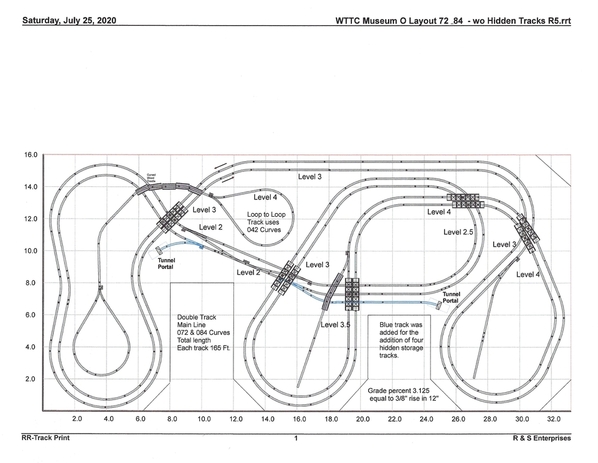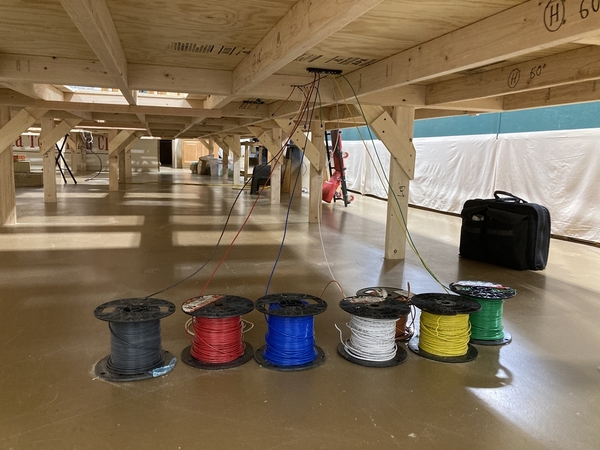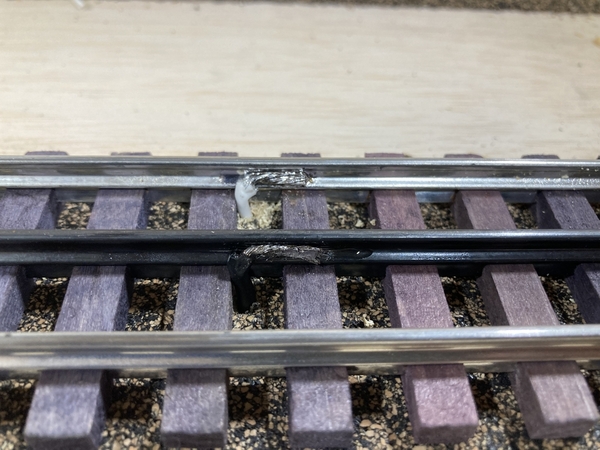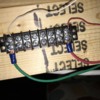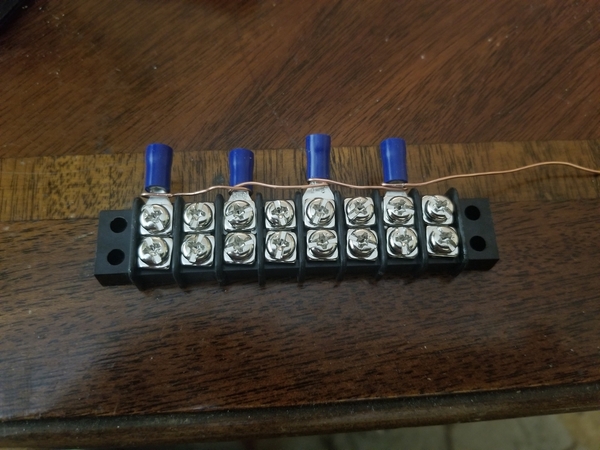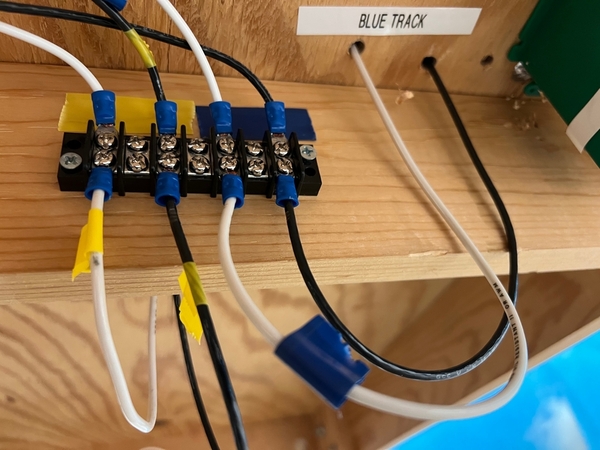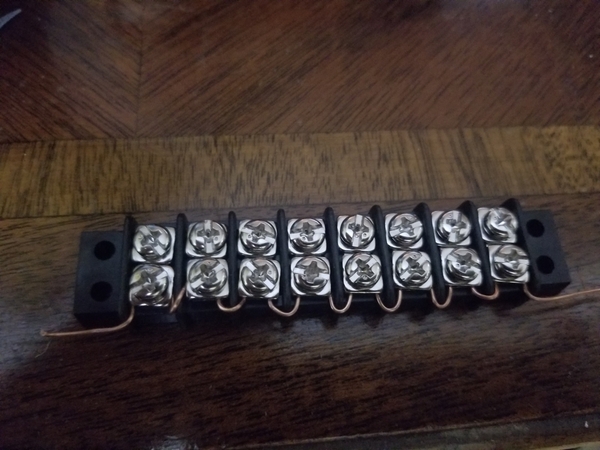Yes. I use those too and they can be cut to any length. Be careful to get the same spacing as your terminal strip.
Arnold, your re-wiring my layout topic has generated a lot of important information that many will prosper from.
btw, when I first saw the original wiring set up you had , I was amazed to see that you knew where every wire went and it’s function! Rats nest was a gentle description. I thought maybe you should call an exorcist! Lol.
but I am thrilled to see the support you have generated.
@Don Merz 070317 posted:Well, you've heard from the prosecution, so let me make a statement for the defense. I LOVE your "invention". In fact, I've been using it for years for all my outer rails. I have copper-clad board at strategic locations around the layout, all wired together and all drops from my outer rails go to these boards using solder connections at both ends.
But all types of connections have their place. For the hot wires, I have 4 junction boxes around the edge of the layout from which I can access any power needed--the center rail for the two nearby local blocks (I use 8 blocks--too many--it probably should have been 4 blocks), 12VDC for LEDs, Miller signs, and etc., and 14VAC for switch machines, accessories and so on. The junction boxes are fed from a cabinet with 12VDC "ham-radio-type" power supplies and a big variac turned way down to 14VAC. At the top of the cabinet is a big line filter that (I hope) cleans the power before it gets onto the layout.
Anyway, pix below. Every setup is different I guess. I just looked for lowest-cost solutions at every step and this is what I ended up with. Everything from copper clad board to terminal strips to spade lug connectors is from my substantial junk box.
Don Merz
Arnold and Don,
Here are two terminal strips/boards that power two rooms full of my table layout. A third, twice the size, came from the old attic layout and powers the third room. Two ZW's, a Z4000, and two small transformers for the trolley lines.
This was over 10 years ago, the beginning of the layout. Pretty crude, but it all works and always has on multiple layouts over the years. Never a problem with these homemade devices.
It's a wire mess under the tables. I'd love to rewire and take advantage of the new connectors and such. It would be nice to clean it all up, color code and label everything but, I haven't the energy or inspiration. The overhead and the new N scale layout get run a lot more than this huge table layout because they are both prominent in the rec room.
Good luck, Arnold, with your wiring project!
Jerry
Attachments
Mounting to wood
If it were a constant circuit
I would not use plywood
but because I’m there when it’s in use, no real concern.
And yes
there are cheaper terminal strips
but for a secure mechanical connection
the electrical panel bus bar is the best I’ve found.
I just bought two 30 terminal strips for $9 each
which will be the point of contact for my toggle switches.
Update: eliminated one of the copper strips.
There is a split of opinion on my invention, which served me fairly well for 25 years, but the wires soldered to the copper strip would occasionally come loose, which could cause short circuits and other problems. Incidentally, if I did a better job soldering, my invention would have worked better.
The hot wires for the left Z4000 throttle that were connected to one of the copper strips, are now connected using fork lugs (both crimped and soldered to the end of the wire) to the red (hot) row on an MTH Terminal block. It is much less likely that any of those wires will ever disconnect. That left Z4000 throttle powers my inner main loop.
Everything else is wired as before.
As a test, I ran a conventional engine, and it ran fine. Then, I ran an MTH Proto 2 engine using DCS, and it ran fine.
About 25% of this re-wiring project is done.
Will give further updates as I make further progress.
All of your input and advice has been very helpful, and I thank you all for it. Arnold
@Bruce Brown posted:As a follow-up to my earlier comment on cheaper alternatives to the MTH distribution block, I failed to mention that the MTH Terminal board has 12 terminals electrically connected to the red post and another 12 connected to the black post. In order to get an equivalent functionality with the cheaper 12-terminal strips, you would need to purchase two strips plus two barrier strips to electrically connect all the terminals together on each strip.
Or even cheaper, a single piece of solid copper wire looped over each terminal, snaking from one screw lug to the next, and tightened securely - very cheap and effective.
George
@GeoPeg posted:Or even cheaper, a single piece of solid copper wire looped over each terminal, snaking from one screw lug to the next, and tightened securely - very cheap and effective.
George
That is a great idea, George, thanks for sharing it. I'm going to do that with the common or ground wire.
Arnold that is one heck of a undertaking.
I have been going through a heck of a under taking by taking charge of our clubs new layout wiring. We really don’t want this to be a rats nest but it needed to be flexible as a lot of the scenery is still not set in stone.
This is what is seen up top the layout (ignore bridges as they only represent what track goes over the other)
we ran a 14AWG “bus” down the length of the layout then came off of that down each of the 3 peninsula’s. From there there were 18AWG feeders every 8ish feet that tied to the main bus.
Unfortunately this is the only picture I have from when we put the bus in. Crimp connectors are used and we soldered the wires to the connector just for good measure.
every drop was then soldered to the Ross/GarGraves track
I don’t have many pictures from under the layout I’ll have to get some more when I’m under it tomorrow.
Attachments
I did the same as George @GeoPeg with my terminal strips under my layout. Worked out great. Below is an example of one terminal strip that is being used to power lamp posts. The screw jumpers went down half the strip and stopped and than continued by a second wire for the other half. This gives me both hot and neutral in one location for four circuits.
Attachments
Applying George's idea, what do you think of the wiring scheme for the ground/common wire, shown in the photo below:
I took a short piece of 18 gauge bare copper wire and wrapped it around the metal stem of each of the 4 fork lugs screwed onto the terminal strip. (If I use this to serve as a common or ground bus wire, I will also solder the short copper wire to each of the 4 metal stems on the lugs).
I will also solder the bare copper wire to the right of the terminal strip to a long 14 gauge stranded black insulated wire the will connect to the black terminal on the MTH Terminal Block near the Z4000 transformer.
Getting back to the Terminal Strip shown in the above photo, I will connect the ground feeder/drop wires (16 gauge solid copper wires from the track lock-ons) to the screw beneath each of the 4 fork lugs.
If the above scheme works, I can substantially reduce the number of wires near the MTH Terminal Block and Z4000 transformer. Doing so would, hopefully, eliminate the rat's nest I had beforehand.
What do you think?
Arnold
Attachments
It just occurred to me that I can daisy chain 7 or 8 of these terminal strip arrangements to each other, running the whole 40 foot length of my layout, and then have only one or two long 14 gauge stranded black insulated wire(s) attached to the black terminal of the MTH Terminal Block near my transformer.
Does that make sense?
I like Rich’s too.
@zhubl posted:Arnold that is one heck of a undertaking.
I have been going through a heck of a under taking by taking charge of our clubs new layout wiring. We really don’t want this to be a rats nest but it needed to be flexible as a lot of the scenery is still not set in stone.
This is what is seen up top the layout (ignore bridges as they only represent what track goes over the other)
we ran a 14AWG “bus” down the length of the layout then came off of that down each of the 3 peninsula’s. From there there were 18AWG feeders every 8ish feet that tied to the main bus.
Unfortunately this is the only picture I have from when we put the bus in. Crimp connectors are used and we soldered the wires to the connector just for good measure.
every drop was then soldered to the Ross/GarGraves track
I don’t have many pictures from under the layout I’ll have to get some more when I’m under it tomorrow.
Zachariah, your club project is much bigger than mine. Thanks for your input, which is very helpful.
How did you connect your feeder wires to your main bus wire?
Arnold
Arnold
The reward for your sharing good advice to hobbyists for years is ... receiving good information from hobbyists when you need help. You got plenty of help!
I had already applied many of the tips to my L-shaped layout:
* MTH terminal blocks for track power via bus wiring and feeders - from a Lionel 135w brick or a MTH Z1000 (the 18v output),
selected by a knife switch
* Barrier Terminal Strips with 14v to action accessories and switches - from a separate MTH Z100 (the 14v output)
* Color coding
* Plastic cable clips for support of under-the-platform wiring (no holes through lumber), avoids the "spaghetti effect"
* Spade lugs for wire connections to terminal strips and ring lugs at connections to #90 control buttons for accessories
* Lighted lockons to confirm power is ON at main lines and insulated sidings (activated by a toggle switch).
Good advice is priceless. Carry on, valiantly ...
Mike Mottler LCCA 12394
Arnold,
Everyone of my track feeds is terminated with a terminal strip as others have discussed. White-black is my wire convention for AC track voltage. I use color tape or label maker to denote which main line the wire is associated. In my case I have Blue, Yellow, and Red main lines. In the photo below I use a larger terminal strip to feed two main lines.
I use a method called Home-Run Wiring with wire pairs going from a central distribution point to each of the feeders. (I use some daisy chaining)
Attachments
In my Trade, we use those types of terminal strips, for lower voltage systems…Door Alarm/Security/Access, which are mostly passive monitoring
Have you noticed, over time, that the screw/wire connection become loose due to heat expansion?
As I said, I like the Electrical Panel Bus Bar, because of the secure mechanical connection..the wire is trapped in the hole, and the square head allows for extra torque, and they don’t come loose.
@1drummer posted:Have you noticed, over time, that the screw/wire connection become loose due to heat expansion?
No, really never. Most of my terminal connections are 25 years old and still tight. My room temperature is maintained in the 64-70 degree F range. None of my track soldered connections have failed either.
This is an update, which I'm sharing to not only get further input, but also to possibly help others regarding the use of terminal strips.
What I have endeavored to do is apply the advice I've received on this thread, particularly that of George and Rich.
I've never had anything like MTH Terminal Blocks or terminal strips until recently, so using this equipment was very foreign to me and awkward.
This afternoon I tried to re-create what Rich did by threading a bare 18 gauge copper wire through the screws of a terminal strip, and found it to be a juggling act that I initially could not do. I decided to take a break for a few hours. (I've found that taking a break enables me to harness my subconscious mind, which in my case, is far more powerful than my conscious mind.)
When I resumed my efforts this evening, I ended up stressing the bare copper wire so much that it broke. LOL. Then, I stripped the insulation off another 18 gauge solid wire and it occurred to me that I had to take the little screw out completely, position the copper wire and then put the little screw back in. Once I did that, it took me a mere 10 minutes to re-create Rich's terminal strip/bare copper wire arrangement. See photo below.
I already have enough 14 gauge stranded copper wire to make long runs from the hot (red) row of terminals from my MTH Terminal Blocks near the Z4000 transformer to the short drop wires connected to the hot connections of all the lock-ons.
(I may later on remove all the lock-ons and solder wires to the sides of rails on my tubular track once I get a high powered Weller D550 soldering gun, which I purchased on-line today).
I am only using terminal strips with the bare 18 gauge copper wire threaded through it (like the one in the photo below) for the cold ground bus wire. Notice there is about 1 inch of bare copper wire at each end of the lower row of screws. I will use that inch of wire to daisy chain the terminal strips.
The top row of screws in the terminal strips (see photo below) will be connected (using fork lugs) to 16 gauge solid drop wires attached to the ground terminal of each lock-on in the vicinity of the particular terminal strip.
I think what I've said makes sense. Do you agree?
Whatever input you can give would be greatly appreciated.
Arnold
Attachments
Arnold,
Looks good. But I could have just mailed you the metal 8-pole jumper strip that would have taken 60 seconds to install. ![]()
![]() I didn't realize you were working so fast!
I didn't realize you were working so fast!





